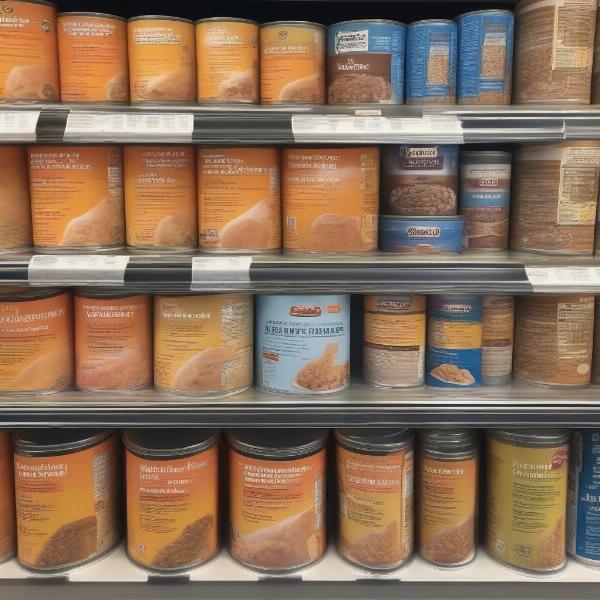Finding the right dog food can feel overwhelming, especially when you’re looking for options packed with meat. Many dog owners prioritize high meat content for various reasons, including perceived health benefits, better palatability, and a desire to mimic a dog’s ancestral diet. This article explores what “dog food with the most meat content” really means, how to identify it, and what to consider when choosing the best option for your furry friend.
Understanding Meat Content in Dog Food
What exactly does “most meat content” mean on a dog food label? Unfortunately, it’s not always straightforward. Labels list ingredients by weight, descending from the heaviest to the lightest. However, ingredients are weighed before processing, which means that meat with high water content may appear higher on the list than a denser, more concentrated protein source after the moisture is removed. This can be misleading. Look beyond the ingredient list and delve into the guaranteed analysis, which provides percentages of protein, fat, fiber, and moisture. Higher protein content often (but not always) correlates with a higher meat content.
Identifying High-Meat Dog Foods
Several clues can help you pinpoint dog foods with substantial meat content. Look for:
- Named Meat Sources: “Chicken meal” is more desirable than generic “meat meal.” Specifically named meat sources, such as “chicken,” “beef,” or “lamb,” as the first few ingredients are a good sign.
- Limited Fillers: Avoid foods with excessive grains, corn, or soy as primary ingredients. These often serve as fillers and contribute less nutritional value compared to meat.
- Guaranteed Analysis: A higher percentage of crude protein is a positive indicator, but remember to consider the moisture content. A dry food with 40% protein will likely contain more meat than a wet food with 10% protein due to the difference in water content.
- “Complete and Balanced” Statement: Ensure the food meets the Association of American Feed Control Officials (AAFCO) standards for complete and balanced nutrition for your dog’s life stage.
Why Choose High-Meat Dog Food?
Some dog owners believe that a diet higher in meat is more closely aligned with a dog’s natural diet. While dogs are not strict carnivores, they can thrive on diets with a substantial meat component. High-meat diets can be beneficial for:
- Picky Eaters: The strong aroma and flavor of meat can entice even the fussiest dogs.
- Muscle Development: Protein is essential for building and maintaining lean muscle mass.
- Energy Levels: Meat provides a readily available source of energy for active dogs.
Considerations and Potential Drawbacks
While high-meat dog food can offer advantages, it’s important to be aware of potential drawbacks:
- Cost: High-quality meat ingredients can be expensive, making these foods pricier.
- Digestibility: Some dogs may have difficulty digesting very high levels of protein.
- Nutritional Balance: Focusing solely on meat content can lead to nutritional deficiencies if other essential nutrients are neglected.
Dr. Emily Carter, a veterinary nutritionist, advises, “While a meat-rich diet can be beneficial, it’s crucial to ensure it’s complete and balanced. Not all high-protein diets are created equal, so consult your veterinarian to determine the optimal diet for your individual dog.”
Choosing the Best Dog Food with High Meat Content
Selecting the right high-meat food involves considering your dog’s individual needs:
- Age: Puppies, adult dogs, and senior dogs have different nutritional requirements.
- Breed: Large breed puppies need specific nutrient ratios to support healthy growth.
- Activity Level: Active dogs require more calories and protein than less active dogs.
- Health Conditions: Certain health issues may necessitate a specialized diet.
 Comparing different dog food labels.
Comparing different dog food labels.
Conclusion
Finding a dog food with high meat content requires careful label reading and understanding your dog’s specific needs. Prioritize named meat sources, limit fillers, and ensure the food provides complete and balanced nutrition. Consulting with your veterinarian can provide personalized guidance and help you make the best choice for your canine companion.
FAQ
- Does higher protein always mean more meat? Not necessarily. Protein can come from sources other than meat. Look for named meat sources in the ingredient list.
- Is a grain-free diet automatically higher in meat? No, grain-free diets may replace grains with other fillers. Always check the ingredient list.
- How much meat should my dog eat? This depends on your dog’s individual needs. Consult your vet for guidance.
- Can a high-meat diet be harmful? It can be if it’s not balanced. Ensure the food meets AAFCO standards.
- What are some signs of protein deficiency? Weight loss, muscle loss, and a dull coat can be indicators.
top dog raw food
is blue a good dog food
foster farm corn dog
taste of the wild dog food for senior dogs
iga dog food
ILM Dog, your trusted source for expert dog care advice, provides comprehensive information on dog breeds, health, training, nutrition, grooming, and much more. We’re committed to helping you navigate the world of dog ownership with confidence. Our expertise covers a wide range of topics, from choosing the right breed to providing tailored nutritional advice, ensuring your furry friend receives the best possible care. For personalized guidance on selecting the perfect dog food for your companion, reach out to our team of experts. Contact us at [email protected] or call us at +44 20-3965-8624. Visit ILM Dog for more valuable resources.